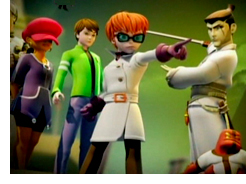Monday, January 4th, 2010

It seems wherever I travel, educational publishers, learning theorists, and teachers of all kinds bring up the concept of learning through interactive games. It’s an idea that’s been picking up steam over the last few years, and why not? Research from the PEW Internet and American Life Project last year found that 98% kids ages 12 – 17 play video games. Organizations like the MacArthur Foundation have been funding a small number of projects to test out new ideas for using interactive games with learning in mind. A few months ago I came across a great article in the Economist about a new public school opening in New York City that uses gaming principles to teach its students. At the recent Breakthrough Learning in a Digital Age conference held at the Google headquarters, I had the opportunity to speak with Katie Salen, the visionary behind this initiative. You can view a short video of my interview with Katie on the Cooney Center YouTube channel or read the complete interview below. Portions of this interview were edited for clarity:
QUICK QUESTION PICKER:
Tell us about your new school, Quest to Learn.
How did you recruit teachers for your school?
Was it hard to get teachers around the concept of teaching from a game design perspective?
How are the students working with the teachers who apply this teaching model?
How do you divide up the class day?
Is it your intent to open up more Quest to Learn schools?
INTERVIEW:
Scott Traylor: Tell us about the work you’re involved in with the start of your new school, Quest to Learn.
Katie Salen: I run a nonprofit called Institute of Play. Two years ago we started work on a new school with an organization called New Visions for Public Schools. Our new school is called Quest to Learn. The MacArthur Foundation gave us a two year planning grant around the school. The work that we’ve been doing at the Institute of Play centers around the idea of games and learning. We’re really interested in the idea of how we can develop a school that doesn’t necessarily use games in the classroom, but does use game design principles in learning spaces. Our idea was to design a school from the ground up built on those ideas.
We opened Quest to Learn this past September. It will eventually be a 6 to 12th grade school but we started with just the sixth grade this year. Next year we will roll in another grade, continuing to add an additional grade each year for the next six years.
Today we have six teachers and 79 students. We’re located in New York City, in Manhattan. It’s a district two school so we could recruit kids from a specific geographic area in Manhattan. (Return to Question Picker)
Traylor: How did you go about recruiting teachers for your school?
Salen: We think the way we recruit teachers is actually very interesting. Our process is one in which anybody we bring into the school needs to be immersed in our model. We held a series of four-hour workshops on Sundays for teachers that were interested in our school. They come in, we put them through a learning problem that kids would have and then they do some work with us around assessment. From the list of interested teachers we narrowed it down to a smaller group and then took them through a series of interviews. We also do direct observation in our classrooms.
We had some really specific criteria for the teachers we were looking for. First, teachers had to be content experts, they had to really know their content. Next, the teachers we looked for have to be really good collaborators. Teachers didn’t necessarily have to be technology people, and a lot of them weren’t necessarily gaming people either, but they were able to work in teams or had come from schools where they worked in teams. They had to have a very good sense of how to enable kids to be innovators. This was very important to us. And finally, teachers had to have done project-based work before, our curriculum includes project-based work in it. Those were the three criteria that we looked for. (Return to Question Picker)
Traylor: Was it hard to get teachers around the concept of teaching from a game design perspective?
Salen: You know, when you begin to explain to a teacher how a game designer thinks about the design of the game, and we’re able to show them a one-to-one parallel with how they think about teaching students, they say “Oh, it’s the same thing.” Then they realize “Oh, maybe it’s the words that are different” and so it’s about helping them understand and translate between something like the term “core mechanic” in games, which talks about the primary activity of the player, and the learning design, because the curriculum is the basic activity of the lesson. It’s a learning curve for everybody. Game language, as with any other language, can feel very specialist, but the concepts aren’t so new. That’s our whole argument. Games actually model good learning and good teachers are immersed in good learning all the time. (Return to Question Picker)
Traylor: Quest to Learn has only been in operation for a short while now. Any observations this early about how the students are working with the teachers who apply this model?
Salen: Well the interesting thing is that the kids are so excited to come to school every day. We have parents saying this is the first time that their student has ever come home excited to tell them about what they’re doing in school. This is the first time that their child gets up out of bed and wants to go to school. So that’s great just from an engagement perspective. It’s a place where kids feel safe. It’s a place where they feel excited about coming which is no small feat for a new school where kids are coming from many different neighborhoods. (Return to Question Picker)
Traylor: How do you divide up the class day?
Salen: When you design a school from the ground up, you attend to every detail. One of the things we spent a lot of time thinking about was the daily schedule. A lot of schools use the Carnegie Unit, classes that are 45 to 50 minutes long. We don’t believe good learning can happen in 45 minutes. From the beginning we wanted to use block scheduling which are extended periods of time.
The main classes we offer, domain classes, last 88 minutes. In a typical day a student will take two domain classes. Since we have an integrated curriculum students will take a class that’s an integrated math/science class and an integrated math/English language arts class. They may be dealing with three or four subjects in a day, but only in two full classes.
There are shorter classes called annex classes, which are extended enrichment and literacy periods. There’s also a gym period for 50 minutes.
For elementary school kids it’s a bit of a shift to be in a class for 88 minutes because they’re used to changing topics with every 45-minute class period. Because our students are working in a problem-based way, the time goes by in a second. (Return to Question Picker)
Traylor: Looking to the future, is it your intent to open up more Quest to Learn schools?
Salen: Everyone always asks us about scale. To be honest, it’s not the first thing we’re thinking about. We’re still in a fact-finding stage to understand what’s working about our model. However, our curriculum is modular. We piloted it in schools before we opened Quest. Everything we produce is open source and online. Any teacher can take what we’ve created and use it right now. The professional development program we have is something that could be used by any school. Our vision is not to make a hundred or two hundred Quest to Learn schools. Over time maybe other organizations will be inspired by the ideas we developed and seek to build schools that share a similar model. (Return to Question Picker)





